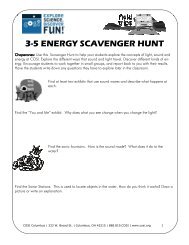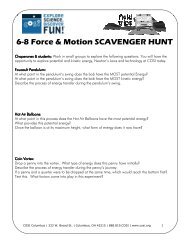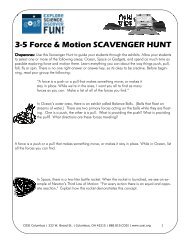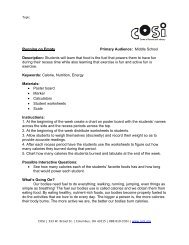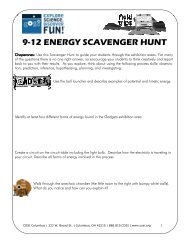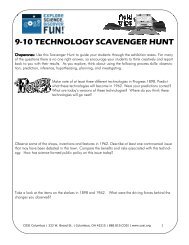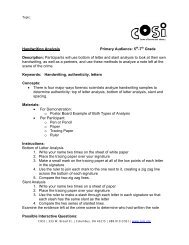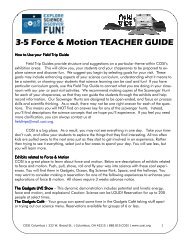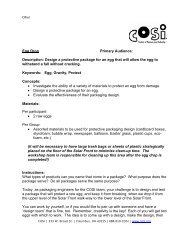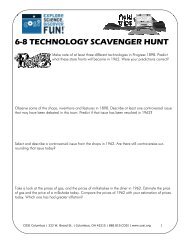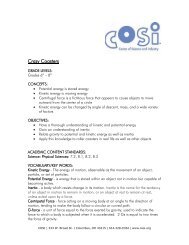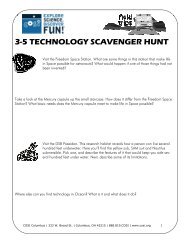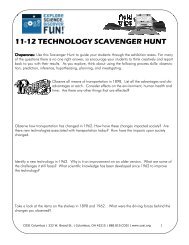6-8 Force & Motion TEACHER GUIDE - COSI
6-8 Force & Motion TEACHER GUIDE - COSI
6-8 Force & Motion TEACHER GUIDE - COSI
Create successful ePaper yourself
Turn your PDF publications into a flip-book with our unique Google optimized e-Paper software.
6-8 <strong>Force</strong> & <strong>Motion</strong> <strong>TEACHER</strong> <strong>GUIDE</strong><br />
OCEAN<br />
Poseidon's realm takes two forms in this unique learning environment. On one side of the exhibition,<br />
Poseidon reigns majestic over a mythical playground, symbolizing the ancient means for understanding<br />
the sea. Here, you can explore the physical nature of water through laminar streams, eroding<br />
sand, and other activities, and at the same time being totally immersed in a theatrical recreation of<br />
the ocean's power. On the other side of Ocean, Poseidon is the namesake of an undersea research<br />
habitat, revealing the modern means for understanding the sea. Based on real ocean exploration<br />
technology, the "D.S.B. Poseidon" uses submersibles sonar to explore the scientific side of Ocean.<br />
Caution: It is likely that your students will get wet. Encourage them to take care not to get others wet in<br />
the process. Exhibits include:<br />
The Cartesian Diver Divers will sink when their density is greater than the water surrounding them.<br />
This is accomplished with a buoyancy compensator (BC) that they wear. As the air is removed,<br />
the BC will deflate. This decreases the divers overall volume, making him/her more dense than<br />
the surrounding water. Can you get <strong>COSI</strong>’s diver to go up and down? How about remain neutrally<br />
buoyant (the middle)?<br />
Erosion Table As water is pulled by gravity to lower levels, it exerts a force of change upon the surface<br />
on which it travels. This force of change is called erosion. The erosion table demonstrates fluvial<br />
(water) erosion on landmass. Where does the sand go? Where is sand washed away<br />
faster? Slower? Why? Are there any areas that have no sand? Where? How would you explain<br />
this observation? What ideas do you have to stop the flow of water? What do you think<br />
will happen when the water is blocked? (Make and share predictions.) Have students construct<br />
a dam with the sand and compare their predictions with their observations about the dam.<br />
Ball Fountains You will notice that the ball is spinning. The moving water sticks to the bottom of the<br />
ball and then is thrown from the top of the ball. The thrown water moves in one direction,<br />
causing the ball to move in the other direction. This is an example of Newton’s Third Law of<br />
<strong>Motion</strong>: For every action, there is an equal and opposite reaction.<br />
Laminar Flow The water coming out of the water cannons is an example of laminar flow. Notice that<br />
this water is much less turbulent than the water in your kitchen sink. Does if feel or look different<br />
than other streams of water you have seen? How is it different?<br />
Water Jets Notice water popping up from the floor. Pumps push the water up and gravity pulls it<br />
back down. What else doe you notice? Does the water spray out or stick together? What<br />
makes it do that?<br />
<strong>COSI</strong> Columbus | 333 W. Broad St. | Columbus, OH 43215 | 888.819.<strong>COSI</strong> | www.cosi.org 3



